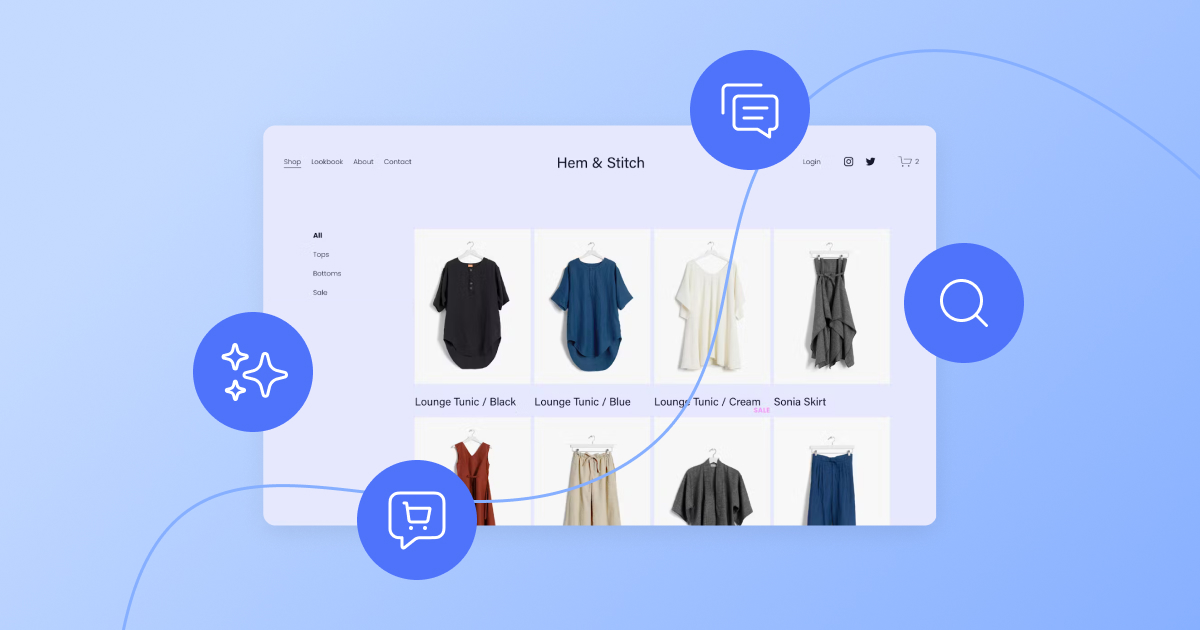Ecommerce trends significantly influence online shopping, affecting everything from where potential customers discover your products or services to how they engage with your brand. Understanding these emerging trends can help you pinpoint areas of your strategy that may need updates to remain competitive.
From artificial intelligence to augmented reality, social media shopping to subscriptions, here are the 10 trends shaping online retail right now:
- Artificial intelligence is transforming the online shopping experience
- Brands are leveraging customer data for personalized experiences
- Social commerce meets customers where they are
- Consumers are all in on subscriptions
- Sustainability-minded consumers lean into the resale economy
- AI-powered chatbots are humanizing self-service experiences
- Consumers make themselves heard with voice search
- Loyalty programs level up with personalization
- Consumers seek more flexible payment options
- Brands use augmented reality to showcase products
Keep reading to learn more about how ecommerce trends are shaping the industry and get the answers to FAQs on the subject.
1. Artificial intelligence is transforming the online shopping experience
Ecommerce is one of the many industries leveraging generative AI to increase efficiency and transform retail experiences. From writing product descriptions to automating customer support queries with chatbots, the opportunities to implement AI are limitless.
Just how prevalent is AI in ecommerce? 84% of ecommerce businesses said AI is their top priority. According to Deloitte, 79% of business leaders agree that generative AI will increase efficiencies in their companies. More than half (52%) believe AI will increase growth opportunities.
It’s not hard to see why: when brands use AI for ecommerce, it drives more than a 25% improvement in customer satisfaction, revenue, and cost reduction. By 2032, the ecommerce AI market is expected to reach $45.72 billion.
2. Brands are leveraging customer data for personalized experiences
Brands collect data at various touchpoints across the ecommerce customer journey. These insights allow companies to pinpoint what’s working (and what’s not) in that journey, take action to remove any friction, and ensure a smooth, holistic experience for their customers.
But that’s not all you can do with that data. Brands are leveraging customer data to create personalized experiences. Experiences like suggesting customized product recommendations based on past purchasing behavior, offering targeted incentives based on browsing history, and syncing orders across various channels (e.g., in-store and online sales).
According to Acxiom, 83% of companies say that using customer data and predictive analytics to improve the customer experience will be a key way to earn customer advantage over the next 5 years. Over a third (36%) of CMOs said implementing systems or algorithms to enhance customer personalization is their top priority, per Deloitte.
Why are online retailers so focused on creating customized shopping experiences? A Google and Storyline Strategies study found that 72% of customers are loyal to brands that offer a personalized customer experience. The more loyal customers are, the more they spend with your brand.
3. Social commerce meets customers where they are
Social media is now more than just a marketing channel: it can also serve as an extension of your storefront. In fact, 67% of customers have shopped via social media this year.
What’s contributing to this rapid rise in social commerce? For one, social media levels the playing field for brands big and small, allowing them to reach new customers and markets, interact with brand advocates and fans, and share new product launches in real time.
Selling on social media also continues to evolve. Platforms like Instagram and TikTok allow users to quickly and easily purchase their favorite products directly from a brand’s account. Younger audiences in particular are the primary target for initiatives like TikTok Shop, given that adults ages 18-24 are 3.2x more likely to buy something from TikTok Shop than the average consumer. This sets the stage for more and more brands to set up shop on the social media platforms catering to online retail.
Meanwhile, influencers help boost brand advocacy and word-of-mouth marketing, encouraging followers to shop the products they love directly on their own channels. A popular form of social media advertising for influencers is adding a ShopMy or LTK link to their social profiles so users can see their product recommendations. Social media influencers also leverage referral and affiliate codes to give customers discounts on the items advertised to them.
4. Consumers are all in on subscriptions
Last year, subscriptions generated over $28 billion in revenue – a figure that doubled from just 4 years ago. Those numbers continue to climb: based on consumer demand, the subscription economy is expected to reach $1.5 trillion by 2025.
One of the reasons consumers are all in on subscriptions is the wide variety of choice – from streaming services to retail products (like clothing, cosmetics, snacks, and even pet food) to fitness memberships to delivery services. Companies successfully leveraging the subscription service model include BarkBox, IPSY, and Nuuly.
Not only do consumers benefit from subscribing, earning loyalty points and member discounts, brands also win with subscriptions that create recurring, predictable revenue that helps them continue to grow.
5. Sustainability-minded consumers lean into the resale economy
With more consumers shopping with sustainability in mind, brands are focusing on how to cater to this cohort of customers: whether that be through selling secondhand items or simply shopping from brands with more sustainable business practices.
Just how prevalent is the resale market? More than half (52%) of consumers have purchased an item secondhand in the past year. And by 2028, the global secondhand market is expected to reach $350 billion.
Younger generations prioritize shopping from sustainable and eco-friendly brands. A study by Drapers and BigCommerce found that 57% of Gen Zers and millennials value sustainability when shopping for clothes, accessories, or shoes – an increase of 21% from 2022.
Ecommerce brands can tap into this trend by encouraging consumers to turn in used items for a store credit (think: Apple Trade In or H&M’s garment collecting program) or opening their own online resale stores.
6. AI-powered chatbots accelerate response times
Another trend among ecommerce businesses is implementing AI-powered chatbots to help resolve customer problems and answer queries faster than humans alone. In fact, 35% of consumers prefer to talk to a chatbot versus an actual customer support agent. Instead of waiting hours if not days for a response to a customer support query, customers can utilize online chatbots to accelerate resolutions to any problem they face.
Chatbots can make or break the customer experience, with 30% of customers saying they wouldn’t use a company’s chatbot again if they had a bad experience. This speaks to the need for ecommerce storefronts to utilize a chatbot service that measures up to what customers expect – not just any chatbot will do.
7. Consumers make themselves heard with voice search
Voice search devices like Amazon Alexa and Google Assistant have changed the way customers shop online – and how brands deliver ecommerce experiences.
How popular is this ecommerce channel? 75% of households are expected to own smart speaker devices by 2025, while 43% of voice-enabled device owners use their device to shop. According to LinkedIn, voice shopping accounts for over $3.3 billion in consumer spending, and is expected to be a $45 billion channel by 2028.
But for consumers, voice search is not a one-way conversation. Google reports that 52% of smart-speaker owners are interested in receiving notifications about deals, sales, and promotions from brands.
8. Loyalty programs level up with personalization
Loyalty programs themselves aren’t a new trend in the world of ecommerce. Brands that want to differentiate their programs – and earn customer loyalty – are leaning on personalization.
According to Acxiom, 65% of consumers want to be rewarded for their loyalty, and 72% are willing to stay loyal to a brand if they offer discounts and rewards. But here’s where personalization turns loyalty into revenue: more than half (56%) of customers said they’re most likely to repurchase from a company if they receive personalized loyalty rewards.
Brands that want to reap the benefits of personalization – and loyal customers – are taking note. According to Gartner, one in three businesses without a loyalty program today plan to establish one by 2027 to shore up first-party data collection and retain high-priority customers. And 9 in 10 companies with an existing program plan to revamp it in the next three years.
9. Consumers seek more flexible payment options
The decision stage of the ecommerce customer journey is one of the most critical. It’s when customers are deciding if they want to move forward with your product or service. They’re adding to their cart – but they haven’t purchased quite yet.
One important factor that weighs on consumers at this stage is their payment options. According to research conducted by Baymard, 13% of customers will abandon their carts if they don’t see enough payment methods available.
To accommodate these customers, more and more brands are offering flexible payment options to help entice customers to buy. These include both multiple payment types, like credit cards or digital payments (think: PayPal or Apple Pay), as well as financing plans, such as the option to buy now, pay later (BNPL).
10. Brands use augmented reality to showcase products
Augmented reality (AR) is transforming ecommerce by helping customers visualize what a product looks like – from trying on clothes to adding new furniture to their home – with an immersive digital experience.
It’s a big hit with consumers. According to Acxiom, 78% of customers who have used AR shopping were satisfied with the experience. AR visuals can help increase conversion as well, with Google reporting products showcasing VR/AR content saw a 94% increase in conversion rate over products without such content.
Consumer confidence is boosting brands’ outlook on the future of AR: 80% of retailers think that most ecommerce brands will have built immersive shopping experiences in the next 5 years.
Ecommerce trends FAQs
What is the future of ecommerce?
The ecommerce landscape is always evolving. New technologies and innovations continue to make online retail an exciting avenue for customers to shop with your brand. From AI, to augmented reality, to personalized recommendations, the ecommerce experience leads the way for retail brands to try out new trends, tune into customers’ preferences, build customer relationships, and iterate to meet customer needs.
Is ecommerce growing?
In short, yes. By 2027, nearly a quarter of retail purchases are expected to take place online. Statista estimates that revenue in the ecommerce market will increase by $657.8 billion between 2024 and 2029.
Is omnichannel still an ecommerce trend?
Omnichannel retail is here to stay, now a vital part of every retail strategy. Nearly three-quarters of customers say they use multiple channels to research products, compare prices, or look for discounts. Brands that master a seamless omnichannel experience across all customer touchpoints, both online and offline, will not only retain current customers, but also continue to win new ones.
How do I know if my business should adopt an ecommerce trend?
Our advice? You have to know your customers before you can know which trends to adopt. And the best way to do this is to ask them. Find out what your customers really want from their ecommerce experience with a retail survey. Or, find out what you can improve in your online shopping experience by following up with a post-purchase survey.
These insights can help you better understand who your customers are and what their preferences are when it comes to shopping (online and in-store), as well as determine which new trends might appeal to them. Ecommerce is always evolving, and your brand should, too.
Start surveying customers in minutes with our free ecommerce survey templates to gather valuable insights into the customer experience.






